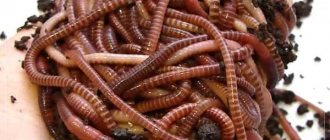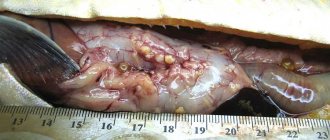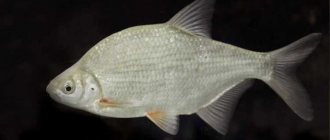In this article we will find out where the name “earthworms” came from, what they eat and what their features are. We have all noticed more than once that after a good rain on the roads and in parks you can see creatures crawling out that have a reddish tint and risk being trampled by people or animals. They are not very pleasant in appearance; small children, as a rule, are afraid of them. But, besides fear, children and adults are still interested in learning what earthworms eat. We will try to answer this question in detail in our article.
What are these creatures?
Biology classifies these representatives of the animal world as annelids. If you look closely at them, then on their thin body (50 mm in diameter, 15-30 cm in length) you can see rings, the number of which can sometimes reach 300. There are also very small worms about 2 cm. Few people know that There are giant worms that reach up to 2 meters in length. But they, like the others, are completely harmless and harmless to humans.
Lifestyle of worms
By their way of life, worms are nocturnal animals, and at night you can watch them swarming everywhere in large numbers, while remaining with their tails in their burrows. Stretching out, they scour the surrounding space, grab with their mouths (at the same time the worm's throat turns slightly outward and then retracts back) raw fallen leaves and drag them into burrows.
Since the body of the worms is unusually extensible, and is also covered with slightly curved back bristles, they are held in the burrow so tightly that it is very difficult to remove them from the ground without tearing them into pieces. The worms remain in their home for most of the day. An exception to this rule is sick individuals infected with parasitic fly larvae. Such animals wander on the surface of the soil in the middle of the day and die
What kind of soil do worms like?
Why do earthworms love sandy loam and loam soils? Such soil is characterized by low acidity, which is best suited for their life. Acidity levels above pH 5.5 are detrimental to the organisms of these representatives of the ringed type. Moist soils are one of the prerequisites for population expansion. During dry and hot weather, worms go deep underground and lose the opportunity to reproduce.
Where can you keep containers of earthworms?
In warm weather, containers can be placed outside. In the cold season - in a barn, basement or apartment. Ready-made humus is odorless, but during the processing of biomass, unpleasant odors can be released and attract insects. To avoid this, you can sprinkle the feed layer with prepared humus and use EM preparations (effective microorganisms) that accelerate the decomposition of organic waste and prevent the appearance of unpleasant odors.
Is it possible to artificially breed earthworms?
It's very possible. This technology is called vermicultivation. feel quite good at home The normal air temperature for worms is between +16 and +24°C (the higher the temperature, the more active the earthworms are and the more food they consume).
It is very important to maintain the correct humidity. Earthworms require a humidity level of 75-80%, and the water must not contain chlorine, otherwise they will die. It is best to use rainwater or settle with tap water. To determine the level of humidity, you can take the soil containing earthworms in your hand and squeeze it: if the moisture does not come out, then the humidity is low, if drops appear, it is high.
The earthworms' need for oxygen is met by loosening the soil using special vermicompost forks with rounded ends.
Earthworms can be kept in wooden or plastic boxes with a volume of 0.5-1 m³, as well as in compost heaps or pits. The acid pH of the environment for earthworms to live should be about 7 (if the pH deviates to 6 or 8, the worms die).
KORETRA FOOD FOR AQUARIUM FISH BREEDING STORAGE PHOTO.
It is recommended to sprinkle the contents of the container with earthworms with straw on top to protect it from drying out and reduce the temperature, and the bottom of the container should have drainage holes to remove excess moisture. Worms do not require lighting; they prefer to be in the dark.
What can you feed earthworms?
First you need to prepare the main nutrient substrate. There are many options for preparing it:
- Cattle manure (for a period of 3-6 months). Fresh manure is destructive to worms, and manure aged for more than two years has too few nutrients.
- Pig manure (for at least a year).
- Manure obtained from small livestock or rabbits can be used after 1-3 weeks.
- Kitchen waste not related to livestock products (meat, milk, eggs): potato peelings, remains of bakery products, fruit, cereals, tea and coffee leaves. In addition, you can use leaves, grass, straw, paper and cardboard in crushed form. Earthworms get used to the same food, and it takes time for them to switch to another. If you need to change their diet, then this should be done gradually, adding new food to the usual in small portions.
The feed mass is added to the boxes in a layer of 5-7 cm every 2-3 weeks, depending on the number of worms and their appetite. The worms leave the processed layer and rise higher to new food. This leaves a layer of humus underneath, ready to be used as fertilizer. Waste, manure and other substances must be crushed before placing them in a vermiculture container.CADDS FLY FOOD FOR RIVER FISH FISHING APPEARANCE PHOTO.
What are the benefits?
First, let's find out what earthworms eat in nature, and what benefits these creatures provide. The role of these individuals in nature is very great - they process all kinds of organic waste, turning them into humus. They swallow particles of biomass along with the soil and thoroughly mix them during digestion.
Humus is the organic basis of the soil; by consuming it, plants acquire the necessary nutrients. 90% of all humus is food for the existence of worms.
Earthworms: feeding method
An earthworm can safely be called an omnivore. He is capable of consuming huge amounts of food. Earthworms often drag food underground and then eat it or store it in special burrows. There they stack the leaves, compacting them and lubricating the spaces between them with soil from their intestines.
These animals are nocturnal. The earthworm's feeding method is very peculiar. Climbing to the surface of the ground in the dark, it tears off a small piece of food, holding it between its protruding upper and lower lips. Meanwhile, the powerful pharynx protrudes forward, creating a fulcrum for the upper lip. Food is first ground in the pharynx, after which it enters the intestines, where it is exposed to special enzymes. Some of the nutrients are absorbed and provide the body with the necessary energy, while the remaining components are released along with the soil and enrich the soil.
The famous scientist Charles Darwin devoted a lot of time to studying the life of earthworms. In his work, he described how these animals consumed the meat that was left to them in advance. In addition, they even ate pieces of their dead brothers. For which the scientist called them cannibals.
Eating worms in nature
Many people are interested in what do earthworms eat in nature? Under natural conditions, these animals consume mainly plant foods, so during artificial breeding it is not recommended to feed them with animal protein.
Favorite food of an earthworm:
- fresh leaves, except very hard veins;
- fallen leaves, which they actively store in burrows;
- rotten parts of stems;
- fallen flowers.
They settle in soil that is rich in humus. They eat leaves, biting off small pieces.
What do earthworms feed on in the soil?
I would like to immediately note that earthworms are omnivores. Since they feed on what is on the surface of the earth, at the same time they swallow a large amount of earth, which gives them the organic elements they need so much. In addition, the worms eat a large number of half-rotten leaves. It is important to note that earthworms do not have teeth directly in the mouth - they are located in the stomach. To receive food, the worm sucks it in with its special organ - the pharynx.
Thanks to the muscles of the body, food moves further, pushing first into the crop and then into the stomach. And already inside, food is ground into small particles by tooth-like protrusions. After this, the food is digested in the intestines by enzymes, useful substances are absorbed, and waste is excreted from the body. Since the worms have a small mouth, this explains why they eat rotten leaves and plant debris. Fresh sprouts can damage the delicate and small body of the worm. Usually such worms live under last year's leaves, where the soil is rich in humus. In such places they are provided with tasty food - pieces of plants, rotted organic matter.
What are the benefits of an earthworm?
It is impossible to overestimate the importance of these earth-dwelling creatures. Considering how worms are useful, first of all, it is worth noting that their presence in the soil is the first sign of its fertility.
Earthworms perform many important functions:
- In search of food, they make tunnels in the ground, which significantly loosens it and facilitates the penetration of air and water into the soil.
- They eat organic debris and plant parts rot faster.
- Enriched with humus. This is the main benefit for soil earthworms.
- Helps increase potassium and phosphorus in the soil.
- Mix the soil with plant residues, and evenly, in the form of small particles, they significantly increase the fertility of the soil.
- Along the passages dug by worms, plant roots move more easily, constantly finding nutritional reserves in them.
- In addition, when considering how earthworms serve the soil, it is worth noting that large stones, due to the movement of soil layers, gradually sink to depth, and small particles are ground almost into dust in the intestines of earthworms.
- Colonies of beneficial bacteria and fungi settle on the walls of the passages dug by these animals.
While digging passages, earthworms swallow soil. One adult individual passes through itself up to 5 g of earth per day, which is equal to its weight.
With the help of these hard workers, any organic residue can be turned into vermicompost - fertilizer for vegetable gardens and flower beds. This is why earthworms are so actively bred on special farms around the world.
In addition to their importance for the soil, earthworms are the main source of food for birds in early spring. This is a kind of bait for them in the gardens. As the weather gets warmer, they turn their attention to insect pests. Fishermen also specially breed worms to use them as bait for fish.
What is the process of eating?
Earthworms drag half-rotten or fresh leaves into their holes and eat them there. Usually they try to tear off small pieces, capturing the edge of the leaf between the protruding upper and lower lips. At such a moment, his throat, protruding, creates a support point for the upper lip. But if the worm encounters a wide flat leaf, it will behave a little differently. The front rings are slightly pulled into the others, thereby expanding the body. At this time, the pharynx is pressed against the plane of the leaf, then pulled back and made a little wider. As a result, a kind of “vacuum” is created in the dimple on the front of the body. The work of the pharynx at this moment is comparable to a piston, and the worm is very firmly attached to the leaf.
In addition to using leaves for food, these creatures cover the entrance to their burrow. To do this, they bring there pieces of stems, dried flowers, paper, feathers and whatever else they find. When a worm has swallowed soil for food or making burrows, it comes to the surface to empty its insides. The soil that the worm expels from the body contains a lot of secretions from the intestinal tract and therefore becomes viscous.
How do earthworms survive winter?
During the winter, the vast majority of individuals hibernate. A sharp drop in temperature can instantly destroy worms, so they try to burrow into the soil to a depth in advance, often exceeding one meter. Earthworms in the soil perform the most important function of naturally renewing it and enriching it with various substances and microelements.
Benefit
In the process of digesting semi-fermented leaves, the worms’ body produces specific enzymes that contribute to the active generation of humic acid. Soil that has been loosened by earthworms is optimal for a wide variety of representatives of the plant kingdom. Thanks to a system of intricate tunnels, excellent aeration and ventilation of the roots is ensured. Thus, the movement of the earthworm is an important factor in the task of restoring the beneficial qualities of the soil. The earthworm is in fact very useful for humans. It makes the soil layers fertile and enriches them with all kinds of nutrients. However, the total number of individuals in many regions of Russia is rapidly declining. This happens due to the uncontrolled introduction of pesticides, fertilizers and mineral mixtures into the soil. Earthworms are also hunted by numerous birds, moles, and various rodents.
What to feed the worm at home?
If you are not aware of what earthworms eat at home and what diet they need, then the following information is just for you. After all, it is necessary not only to create optimal living conditions, but also to provide the necessary nutrition for these individuals. Consider the food that can be used for an earthworm:
- Food waste (shells, peelings).
- Horse or goat manure.
- Tea leaves, coffee grounds, leaves, grass.
It is worth paying attention to what earthworms feed on and what is unacceptable for them. You need to know that the manure for feeding should not be fresh, but rotted, otherwise the worm will simply die. All this is due to the large amount of ammonia, which is found in fresh manure and is very harmful to your pets. There is no oxygen in an ammonia environment, so sometimes individuals die.
Earthworm structure
- An earthworm consists of a digestive tube placed within a thick cylindrical muscular tube that forms the body.
- The body is divided into segments, and grooves on the surface of the body mark the division between each segment.
- The first segment covers the mouth and has a fleshy, muscular lobe at the apex. This lobe may be extended to close the mouth or extended forward to explore the immediate environment.
- All segments except the first have eight retractable bristles that help the earthworm grip surfaces as it moves. The picture below shows some of the internal features of an adult earthworm.
- Earthworms are hermaphrodites, meaning they have male and female reproductive organs.
- When two earthworms are ready to mate, they adopt a head-to-tail position, become coated in a layer of mucus, and exchange sperm. The girdle forms a mucous tube that breaks off and moves forward along the body, collecting the earthworm's own eggs and sperm received from its partner along the way.
- Fertilization occurs in a mucous tube that sheds from the front end of the earthworm and dries in the soil to become an egg capsule from which one or more young earthworms will eventually hatch. Many species can breed several times a year.
What not to do?
Also, when breeding pets at home, it is not recommended to feed them with fish, meat and dairy products. Also eliminate salty foods from your diet. In addition, neither canned cucumbers, nor tomatoes, nor cabbage will bring any benefit. You need to remember that feeding the worm once a week is enough. To do this, you need to crush the food and put it on the ground. The feed layer is allowed up to 10 cm.
When it comes to what earthworms eat, you need to know that they usually get used to the same food, and it will take them some time to switch to a different diet. If you decide to change their diet, then you need to do this gradually, adding new food to the usual in small portions.
As a rule, the feed mass is placed in boxes 5-7 cm thick once every 3 weeks, depending on the number, size and appetite of the worms. When they process one layer, they soon leave it and rise higher to a new one. After processing, humus remains in the lower layer, which can be used as fertilizer.
Not only is it important for us to know what earthworms eat, but we should also remember that these individuals are inconspicuous, quiet workers who make the soil fertile. They are the most important friends and helpers for gardeners and gardeners. They need to be protected and helped in every possible way.
Earthworm Reproduction
Earthworms are hermaphrodites, in which each earthworm contains both male and female reproductive organs. The male and female reproductive organs can produce sperm and eggs, respectively, in each earthworm. Although earthworms are hermaphrodites, most require a helper to reproduce. During mating, the two worms line up, facing away from each other, so that sperm can be replaced. Each earthworm has two male openings and two sperm vessels that collect sperm from the other mate. Earthworms have a pair of ovaries that produce eggs. A mucous tube forms around it, which is filled with protein fluid. The earthworm will emerge from the mucus tube. When the earthworm passes through the mucus tube, the tube will pass through the female pore, collecting eggs. The tube will continue to move down the earthworm and pass through the male pore, called the spermatheca, which stores sperm, called a spermatozoon. The eggs will be fertilized and the mucus tube will close when the worm is completely out of the tube. The slime tube will form an "egg cocoon" and be placed in the soil. The fertilized eggs will develop into young worms.











